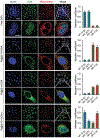Targeted Heating of Mitochondria Greatly Augments Nanoparticle-Mediated Cancer Chemotherapy
- PMID: 32548935
- PMCID: PMC7879459
- DOI: 10.1002/adhm.202000181
Targeted Heating of Mitochondria Greatly Augments Nanoparticle-Mediated Cancer Chemotherapy
Abstract
Cancer is the second leading cause of mortality globally. Various nanoparticles have been developed to improve the efficacy and safety of chemotherapy, photothermal therapy, and their combination for treating cancer. However, most of the existing nanoparticles are low in both subcellular precision and drug loading content (<≈5%), and the effect of targeted heating of subcellular organelles on the enhancement of chemotherapy has not been well explored. Here, a hybrid Py@Si-TH nanoparticle is reported to first target cancer cells overexpressed with the variant CD44 via its natural ligand HA on the outermost surface of the nanoparticle before cellular uptake, and then target mitochondria after they are taken up inside cells. In addition, the nanoparticle is ultraefficient for encapsulating doxorubicin hydrochloride (DOX) to form Py@Si-TH-DOX nanoparticle. The encapsulation efficiency is ≈100% at the commonly used low feeding ratio of 1:20 (DOX:empty nanoparticle), and >80% at an ultrahigh feeding ratio of 1:1. In combination with near infrared (NIR, 808 nm) laser irradiation, the tumor weight in the Py@Si-TH-DOX treatment group is 8.5 times less than that in the Py@Si-H-DOX (i.e., DOX-laden nanoparticles without mitochondrial targeting) group, suggesting targeted heating of mitochondria is a valuable strategy for enhancing chemotherapy to combat cancer.
Keywords: conductive polymers; drug delivery; mitochondria targeting; photothermal therapy; ultrahigh anti-cancer efficiency.
© 2020 WILEY-VCH Verlag GmbH & Co. KGaA, Weinheim.
Conflict of interest statement
Conflict of Interest
The authors declare no conflict of interest.
Figures





Similar articles
-
A novel near-infrared triggered dual-targeted nanoplatform for mitochondrial combined photothermal-chemotherapy of cancer in vitro.Nanotechnology. 2019 Jan 18;30(3):035601. doi: 10.1088/1361-6528/aaebca. Epub 2018 Nov 12. Nanotechnology. 2019. PMID: 30418947
-
Tumor-targeted and multi-stimuli responsive drug delivery system for near-infrared light induced chemo-phototherapy and photoacoustic tomography.Acta Biomater. 2016 Jul 1;38:129-42. doi: 10.1016/j.actbio.2016.04.024. Epub 2016 Apr 16. Acta Biomater. 2016. PMID: 27090593
-
Graphene quantum dots-gated hollow mesoporous carbon nanoplatform for targeting drug delivery and synergistic chemo-photothermal therapy.Int J Nanomedicine. 2018 Oct 4;13:5991-6007. doi: 10.2147/IJN.S175934. eCollection 2018. Int J Nanomedicine. 2018. PMID: 30323587 Free PMC article.
-
Nanoparticle-based therapeutic strategies for mitochondrial dysfunction in cardiovascular disease.J Biomed Mater Res A. 2024 Jun;112(6):895-913. doi: 10.1002/jbm.a.37668. Epub 2024 Jan 12. J Biomed Mater Res A. 2024. PMID: 38217313 Review.
-
Heating Induced Nanoparticle Migration and Enhanced Delivery in Tumor Treatment Using Nanotechnology.Bioengineering (Basel). 2024 Sep 7;11(9):900. doi: 10.3390/bioengineering11090900. Bioengineering (Basel). 2024. PMID: 39329642 Free PMC article. Review.
Cited by
-
Mitochondrial Metabolism: A New Dimension of Personalized Oncology.Cancers (Basel). 2023 Aug 11;15(16):4058. doi: 10.3390/cancers15164058. Cancers (Basel). 2023. PMID: 37627086 Free PMC article. Review.
-
Fe-doped carbon dots: a novel biocompatible nanoplatform for multi-level cancer therapy.J Nanobiotechnology. 2023 Nov 17;21(1):431. doi: 10.1186/s12951-023-02194-6. J Nanobiotechnology. 2023. PMID: 37978538 Free PMC article.
-
Sequential Drug Delivery in Targeted Cancer Therapy.Pharmaceutics. 2022 Mar 5;14(3):573. doi: 10.3390/pharmaceutics14030573. Pharmaceutics. 2022. PMID: 35335949 Free PMC article. Review.
-
The development and evaluation of hyaluronic acid coated mitochondrial targeting liposomes for celastrol delivery.Drug Deliv. 2023 Dec;30(1):2162156. doi: 10.1080/10717544.2022.2162156. Drug Deliv. 2023. PMID: 36600637 Free PMC article.
-
Targeted peptide-modified oxidized mesoporous carbon nanospheres for chemo-thermo combined therapy of ovarian cancer in vitro.Drug Deliv. 2022 Dec;29(1):1947-1952. doi: 10.1080/10717544.2022.2089298. Drug Deliv. 2022. PMID: 35758337 Free PMC article.
References
-
- Miller KD, Siegel RL, Lin CC, Mariotto AB, Kramer JL, Rowland JH, Stein KD, Alteri R, Jemal A, Cancer J Clin. 2016, 66, 271; - PubMed
- Wang H, Agarwal P, Zhao S, Yu J, Lu X, He X, Nat. Commun 2015, 6, 10081; - PMC - PubMed
- Oualla K, El-Zawahry HM, Arun B, Reuben JM, Woodward WA, Gamal El-Din H, Lim B, Mellas N, Ueno NT, Fouad TM, Ther. Adv. Med. Oncol 2017, 9, 493; - PMC - PubMed
- Schettini F, Giuliano M, De Placido S, Arpino G, Cancer Treat. Rev 2016, 50, 129; - PubMed
- Locatelli MA, Curigliano G, Eniu A, Breast Care 2017, 12, 152; - PMC - PubMed
- Yao H, He G, Yan S, Chen C, Song L, Rosol TJ, Deng X, Oncotarget 2017, 8, 1913; - PMC - PubMed
- Zeichner SB, Terawaki H, Gogineni K, Breast Cancer 2016, 10, 25. - PMC - PubMed
-
- Dean M, Fojo T, Bates S, Nat. Rev. Cancer 2005, 5, 275. - PubMed
-
- Blanco E, Shen H, Ferrari M, Nat. Biotechnol 2015, 33, 941; - PMC - PubMed
- Sherlock SP, Tabakman SM, Xie L, Dai H, ACS Nano 2011, 5, 1505; - PMC - PubMed
- Langer R, Science 249, 1990, 1527; - PubMed
- Farokhzad OC, Langer R, ACS Nano 2009, 3, 16; - PubMed
- Hare JI, Lammers T, Ashford MB, Puri S, Storm G, Barry ST, Adv. Drug Delivery Rev 2017, 108, 25; - PubMed
- Wilhelm S, Tavares AJ, Dai Q, Ohta S, Audet J, Dvorak HF, Chan WCW, Nat. Rev. Mater 2016, 1, 16014.
Publication types
MeSH terms
Substances
Grants and funding
LinkOut - more resources
Full Text Sources
Medical
Miscellaneous

